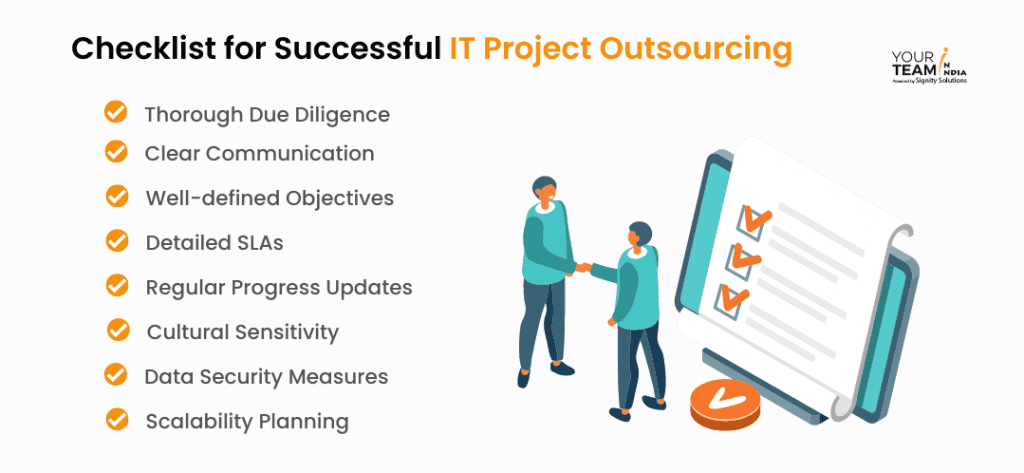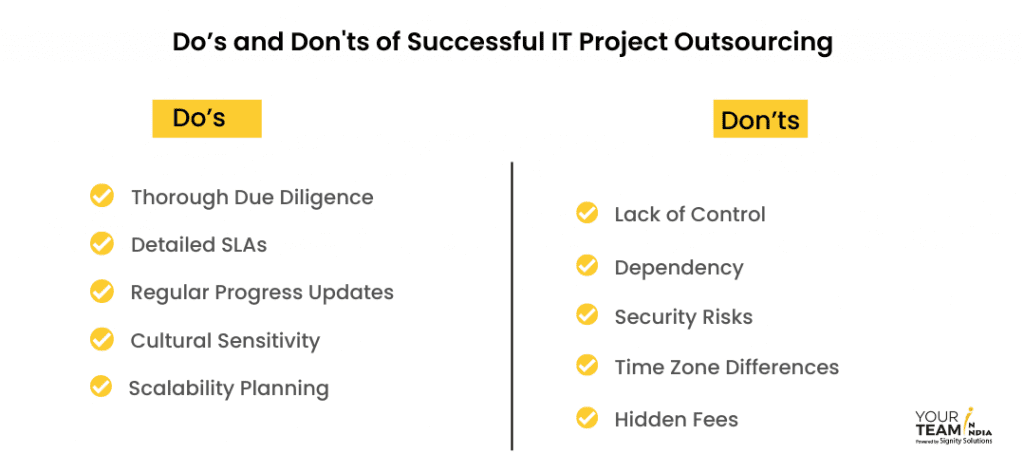Quick Summary: In today's fast-paced digital landscape, IT project outsourcing has emerged as a game-changer for startups. This article explores the myriad ways in which outsourcing IT projects can empower startups to harness expert talent, reduce costs, accelerate development, and ultimately, achieve their business goals with agility and efficiency.
Are you a startup founder struggling to keep up with the demands of your IT projects? If so, you’re not alone. IT projects can be complex and time-consuming, and they can distract you from business aspects that matter.
But what if there’s a way to get the IT support you need without sacrificing your time or resources? IT project outsourcing can be the answer.
Outsourcing your IT projects to a qualified provider can free up your time and resources so you can focus on what you do best: building your business. It can also save you money and give you access to a team of experts with the experience and knowledge to complete your projects.
In this blog post, we’ll discuss what is IT project outsourcing, its benefits for startups, and how to choose the right provider for your needs. Let’s begin:
Understanding IT Project Outsourcing
IT project outsourcing is the business practice of hiring third-party vendors and service providers to handle IT projects, tasks, and operations that they would otherwise perform in-house.
Here’s why IT project outsourcing is a great option for startups:
- Startups can save money on labor and operational costs by outsourcing their IT projects to a third party.
- With outsourcing, startups can access skills their in-house team may not have to handle their IT projects successfully.
- With outsourcing, startups can free up their internal resources for more crucial tasks and projects.
- By outsourcing IT projects, startups can focus on their core business activities and improve their productivity.
What Type of IT Projects Can You Outsource as a Startup Owner?
Here are some common types of IT projects and IT services that you can outsource as a startup owner:
- Development of new software applications and websites. It can save time and money while offering you access to global talent.
- Management of IT infrastructure, such as servers, networks, and data centers. It can free up your internal resources to focus on more essential tasks.
- Management of IT security, such as firewalls, intrusion detection systems, and data encryption, to protect your sensitive data from cyber-attacks.
- Provision of IT support, such as helpdesk services and technical support. It would ensure your employees have the support they need to use their IT systems effectively.
- IT consulting services to help with a variety of IT-related tasks, such as strategic planning, IT procurement, and IT risk management.
Recommended Read: Minimizing IT Infrastructure & Development Cost with Outsourcing
Benefits of IT Project Outsourcing for Startups
1. Access to Specialized Expertise
Startups often don’t have the in-house expertise to handle complex IT projects. Hiring experts is also not an option, as it’s time-consuming and expensive.
IT project outsourcing solves this problem by offering you access to experienced IT professionals worldwide. You can easily hire them, get them to work on your project the way you want, and terminate their services when you don’t need them.
2. Cost Savings
Managing IT projects in-house can cost you a lot of savings as you must hire and train your in-house IT staff and bear operational expenses. It can be a lot of monetary burden for startups with limited budgets.
IT project outsourcing can save you money by eliminating these operational expenses. This way, you can finish your projects on a much less budget.
You can also use our outsourcing calculator to determine how much outsourcing an IT project can cost.

3. Faster Time-to-Market
Managing IT projects in-house is time-consuming because of the following factors:
- Identifying the right team members with suitable skills and availability takes time, as you need to consider current workloads, skill sets, and availability within your team.
- It takes time for team members to familiarize themselves with new tools, frameworks, or programming languages.
- The in-house team often has other high-priority tasks they may need to address first.
- Defining the project scope and requirements takes time, as you need to incorporate the opinions of all the stakeholders.
- Internal decision-making can be slow.
With IT project outsourcing, you don’t have to worry about everything. IT services provider is responsible for defining project requirements, assigning a team, or familiarizing the team with the latest technologies. You only need to monitor the work and ensure everything happens on time and as per the defined requirements. This way, you can save time and release your product in the market faster.
4. Focus on Core Business Activities
Managing IT projects in-house can put an extensive load on you. It can take a lot of your time, budget, and effort and leaves you with little room to focus on things that matter.
IT project outsourcing allows you to focus on your core business activities and grow your business more quickly and efficiently.
5. Risk Mitigation
Managing IT projects in-house involves many risks, such as delays, cost overruns, and scope creep. As a result, your IT projects can quickly turn into a nightmare.
Outsourcing IT projects reduces these risks by patching you with a team of certified professionals. As a result, you can avoid costly IT problems that could damage your business and become a barrier to your growth.

Six-step IT Project Outsourcing Process
You can outsource your IT projects to IT outsourcing companies in the following six steps:
Step 1: Define Your Project Requirements
In this phase, you define the project scope, objectives, deliverables, budget, timeline, and desired outcomes. Here are the questions you answer at this stage:
- What are you looking for in an outsourcing partner?
- What are your requirements?
- What do you want the outsourcing partner to deliver, and by when?
- How much are you willing to spend on the project?
But if you don’t have these details, you should be able to describe your idea briefly, and a team of IT service providers can help you figure out what services you need to outsource.
You can also write a request for a proposal if you want to ensure a win-win relationship with an IT services provider. In this document, you can define your requirements and expectations from the collaboration in detail and receive a comprehensive response.
Step 2: Search for Potential Outsourcing Partners
In this phase, you search for an IT services provider with whom you want to collaborate. You can do it through online research, referrals from your connections, platforms like Clutch and Goodfirms, or hiring a third-party consultant.
You need to understand your requirements clearly to select the right outsourcing partner. Only when you know what type of services you’re looking for can you make the right decision?
Step 3: Evaluate & Select the Right Outsourcing Partner
At this stage, you evaluate potential outsourcing partners based on their experience, expertise, reputation, and references. There are many ways to assess a potential outsourcing partner, such as interviews, portfolio reviews, etc. You can choose the one that suits you.
Here are a few tips for choosing the right outsourcing partner:
- Choose an outsourcing partner with enough expertise and experience in the domain relevant to yours.
- Carefully review their portfolio. Ensure that they’ve done projects related to yours.
- Evaluate their security policies, communication methods, and business continuity plan to ensure you’re putting your project in the right hands.
Once you finalize a suitable outsourcing partner, negotiate the terms of the engagement. Don’t proceed unless you agree on the scope of work, cooperation model, budget, and timeline.
Step 4: Develop the Contract
The purpose of a contract is to communicate all the conditions mentioned in the previous stage, i.e., scope of work, timeline, budget, and model of cooperation. It ensures that both parties agree on the project expectations, deliverables, timeline, and payment terms.
Here are the questions you must answer in the IT contract:
- What services would the IT services provider provide?
- What specific deliverables would the IT provider offer?
- When will the IT provider deliver the services and deliverables?
- How much would the IT provider charge for its services and deliverables?
- When and how will you pay the IT services provider?
- What information will be shared between both the parties?
- Who owns the intellectual property rights to the software and any other deliverables?
- Under what circumstances can either party terminate the contract?
- How will any disputes between the parties be resolved?
Hiring an attorney or contract specialist while drafting a contract would also be best. While it may cost you a few thousand extra bucks, it would be worthwhile in the long run as it prevents you from drafting a loose contract.
Step 5: Begin the Project
Once the contract is ready, you’re officially in business with the outsourcing partner. Now, they can start working on the project, and you can regularly monitor its progress.
Communication is critical at this stage as it keeps you and the outsourcing partner on the same page. Hence, it would be best to focus on establishing effective communication channels. Also, ensure that the outsourcing partner regularly communicates the project progress via task updates, status meetings, and other communication channels.
Also, pay attention to any challenges that might hamper your project progress. This way, you can identify and address them before they become a major problem.
Last but not least, make sure everyone feels supported and heard. Your outsourcing partner would help you more if you do the same for them. So, be supportive and available when they need you.
Step 6: Project Closure
We complete all the activities in this stage and formally end the project. However, first, we review the project plan and compare it to the deliverables. The idea is to ensure the project has been completed per the agreed-upon expectations.
Once we establish that the project has met all the expectations and resolved all the issues, the outsourcing partner formally signs off. But if you’re impressed with their work, you may extend the contract.
When Should You Opt For IT Project Outsourcing?
Here are five common scenarios when opting for IT project outsourcing makes sense:
- You have a limited budget for software development and want to reduce costs. IT project outsourcing has lower labor expenses and is more affordable.
- You have a limited time. An IT services provider can complete your project faster than an in-house team, improving time-to-market.
- Your in-house team lacks the expertise to develop a particular product or feature. With IT project outsourcing, you can access a global talent pool with skills and experience to work on your project efficiently.
- It would be best to have specialized professionals that your team doesn’t have in-house. IT outsourcing providers have a large pool of technical resources that you can quickly deploy on your project instead of hiring them in-house, which can be time-consuming.
- You want to grow your business quickly but don’t have time to build resources from scratch. Outsourcing companies have a team ready to jump in and help you with your project. The best part is that you can scale down the outsourced resources when the demand drops. You don’t need to worry about layoffs.
Tips for Successful IT Project Outsourcing
Here are some tips that you must consider to outsource your IT projects successfully:
1. Do Enough Research
Most businesses skip research before choosing an outsourcing partner because they think it is time-consuming. As a result, they choose an outsourcing partner who fails to do justice to their money, time, and vision.
Research is critical as factors like company portfolio, expertise, reviews, and cost help you decide which outsourcing partner to choose. Hence, do enough research and compare different options before you select an outsourcing partner that meets your requirements.
2. Consider the Location, Expertise, and Experience
While the research will set the stage for successful outsourcing, choosing the right outsourcing partner is up to you. Hence, you must choose carefully.
It would be best to consider the following to choose the right software development outsourcing partner:
- Partner’s Experience: An experienced partner will handle your project much better, as they have dealt with them.
- Expertise: You must choose a partner who specializes in the technologies related to your project. It ensures they would build a high-quality product.
- Location: Choose the outsourcing partner’s location wisely. Outsourcing in India can cost you almost 1/5th of what it would cost in the USA. So, choose the location carefully, as a wrong choice can significantly boost your app development costs.
All these things will help you decide which outsourcing partner suits your project.
3. Set Clear Expectations
Failing to communicate expectations to the outsourcing partner often leads to confusion and a poor-quality product. You must set clear expectations with your outsourcing partner and communicate them effectively.
Here are the things that you must clear with your outsourcing partner right from the beginning:
- What are the services and deliverables the outsourcing partner would provide?
- By when the outsourcing partner would deliver these services?
- How much would the outsourcing partner charge you, and how would you make these payments?
Setting clear expectations would help you avoid misunderstandings and ensure the product turns out to be as expected.
4. Communicate Regularly
Communication is the key to successful outsourcing relationships. The lack of it often leads to misunderstanding and frustrations. That’s why you must regularly communicate with your outsourcing partner.
Here’s what you can do:
- Regularly ask the outsourcing partner for project updates.
- Host regular catch-ups, asking them how the project is progressing and what are the blockers they’re facing.
- Involve yourself in the development process right from the beginning. Ask questions, provide feedback, and listen to the suggestions your outsourcing partner has to share with you. This way, you can improve the quality of your product.
5. Use Project Management Tools
Outsourcing is a complex process. You can’t manage everything manually as it would be chaotic and time-consuming. Instead, you need project management tools to help you track progress, identify and resolve projects, and ensure the project is completed on time.
A few popular project management tools that you can use are:
- Trello
- Asana
- Basecamp
6. Consider Different IT Outsourcing Models
Many IT outsourcing models exist, each with advantages and disadvantages. Let’s have a look:
- Onshore outsourcing is a traditional model where you can outsource the work to an outsourcing partner from the same country. You get the advantage of close communication, collaboration, and managing the project easily. However, it is expensive.
- In Nearshore outsourcing, you outsource your project to an outsourcing partner from a neighbouring country. You may experience lower labor costs and cultural proximity.
- In offshore outsourcing, you can outsource your project to a provider in a country far from the client. It offers the advantage of lower labor costs but comes with challenges like cultural differences and communication difficulties.
- Hybrid outsourcing combines two or more models, i.e., you outsource some of the work to an onshore provider and other work to an offshore provider. As a result, you get the best of both worlds, such as lower labor costs and close communication.
- In staff augmentation, you hire a team of IT professionals from a third-party provider to supplement your in-house team. It can be a good option if you need to quickly scale up your IT capabilities or specialized skills not available in-house.
- Managed services involve hiring a third-party provider to manage your IT infrastructure and operations. It can be a good option to outsource the day-to-day management of your IT systems and focus on your core business activities.
Based on your business needs and budget, you can choose the IT outsourcing model that best suits your requirements and select the outsourcing partner who can do justice to your needs.

In Conclusion,
IT project outsourcing is a great option as it can help you access global talent and build your project faster. However, it can also be unpredictable and daunting. If you are not aware, outsourcing can quickly turn into a nightmare.
Especially if you’re a startup with a tight budget, wrong IT project outsourcing choices can quickly inflate your project budget. Hence, it’s essential to be aware before you attempt to outsource your IT project.
Hopefully, the blog gave you enough idea of what IT project outsourcing is, how it can benefit your startup, and how you can make the most of it. Now, it’s time to implement the knowledge and find a suitable IT outsourcing company to work on your project.
Are you looking for a reliable IT outsourcing partner in India? We can help. Contact us!







